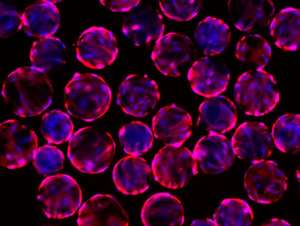Producing mesenchymal stem cells in large numbers requires careful tuning of the growth media

Mesenchymal stem cells (MSC) have a vital therapeutic role, yet can still only be manufactured in relatively small batches. A*STAR researchers have made advances in finding a better growth media.
MSCs that can develop into bone, cartilage, muscle or fat cells show promise in treating human disease and are in late stage clinical trials for more than a dozen indications, explains Steve Oh from A*STAR. "In total there are around 400 trials globally" says Oh, but "if any of these trials lead to blockbuster therapies there is not enough serum available to sustain manufacturing of the cells."
Currently MSCs are grown in a single layer on a culture dish in media often containing animal serum. To scale up production cells will have to be grown in larger volumes and in media that does not contain animal serum as this can vary from batch to batch.
A team led by Oh and Kah Yong Tan, also at A*STAR's Bioprocessing Technology Institute, wanted to know how effective current serum-free media formulations are at sustaining MSC growth. They compared proliferation of seven MSCs lines in six different media compositions, either in a dish or on small beads, called microcarriers, which can support large numbers of cells.
Their findings were disappointing, but not surprising. No single media supported growth of all MSC lines and a medium that performed well in monolayer cultures did not necessarily lead to growth on the microcarrier.
"The MSCs come from a variety of sources; the bone marrow, the umbilical cord, adipose tissue," explains Oh, "it is likely that growth and attachment requirements will be different and need to be optimized for each cell line."
The work was done in static microcarrier cultures with no agitation. Scaling up production really requires the cells to be stirred. "To switch cells from static to shaker culture is critical," explains Oh "and then we need to look at functional aspects as well as stem cell markers."
Oh is currently working with a company to develop a generic medium that will support more MSC lines. While a single medium to grow all MSC lines may not be realistic Oh hopes that two or three formulations will support the growth of most lines.
Oh and Tan's work lays the groundwork for finding the optimal media. The next step is to identify a definitive method of how to grow MSCs on a scale needed for therapy.
More information: Kah Yong Tan et al. Serum-free media formulations are cell line–specific and require optimization for microcarrier culture, Cytotherapy (2015). DOI: 10.1016/j.jcyt.2015.05.001















